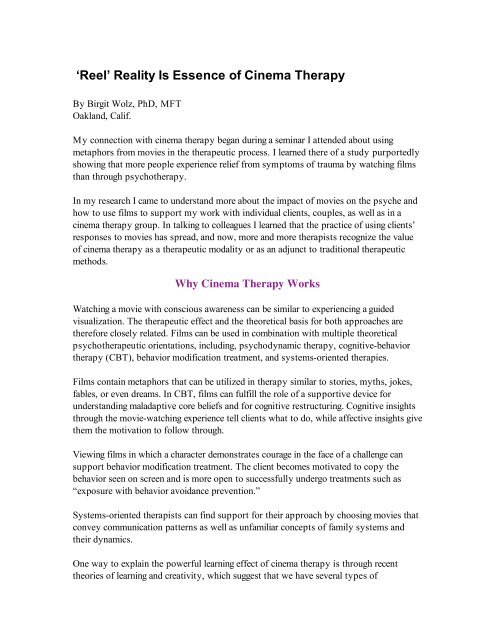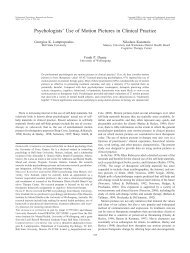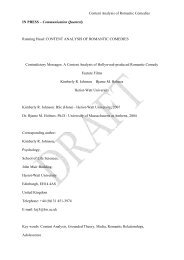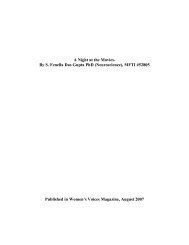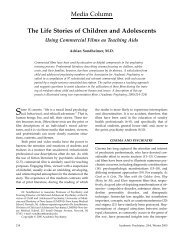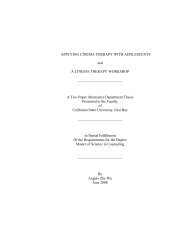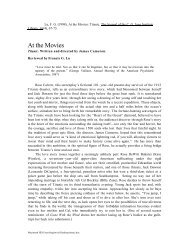'Reel' Reality Is Essence of Cinema Therapy - Cinematherapy.com
'Reel' Reality Is Essence of Cinema Therapy - Cinematherapy.com
'Reel' Reality Is Essence of Cinema Therapy - Cinematherapy.com
You also want an ePaper? Increase the reach of your titles
YUMPU automatically turns print PDFs into web optimized ePapers that Google loves.
‘Reel’ <strong>Reality</strong> <strong>Is</strong> <strong>Essence</strong> <strong>of</strong> <strong>Cinema</strong> <strong>Therapy</strong><br />
By Birgit Wolz, PhD, MFT<br />
Oakland, Calif.<br />
My connection with cinema therapy began during a seminar I attended about using<br />
metaphors from movies in the therapeutic process. I learned there <strong>of</strong> a study purportedly<br />
showing that more people experience relief from symptoms <strong>of</strong> trauma by watching films<br />
than through psychotherapy.<br />
In my research I came to understand more about the impact <strong>of</strong> movies on the psyche and<br />
how to use films to support my work with individual clients, couples, as well as in a<br />
cinema therapy group. In talking to colleagues I learned that the practice <strong>of</strong> using clients’<br />
responses to movies has spread, and now, more and more therapists recognize the value<br />
<strong>of</strong> cinema therapy as a therapeutic modality or as an adjunct to traditional therapeutic<br />
methods.<br />
Why <strong>Cinema</strong> <strong>Therapy</strong> Works<br />
Watching a movie with conscious awareness can be similar to experiencing a guided<br />
visualization. The therapeutic effect and the theoretical basis for both approaches are<br />
therefore closely related. Films can be used in <strong>com</strong>bination with multiple theoretical<br />
psychotherapeutic orientations, including, psychodynamic therapy, cognitive-behavior<br />
therapy (CBT), behavior modification treatment, and systems-oriented therapies.<br />
Films contain metaphors that can be utilized in therapy similar to stories, myths, jokes,<br />
fables, or even dreams. In CBT, films can fulfill the role <strong>of</strong> a supportive device for<br />
understanding maladaptive core beliefs and for cognitive restructuring. Cognitive insights<br />
through the movie-watching experience tell clients what to do, while affective insights give<br />
them the motivation to follow through.<br />
Viewing films in which a character demonstrates courage in the face <strong>of</strong> a challenge can<br />
support behavior modification treatment. The client be<strong>com</strong>es motivated to copy the<br />
behavior seen on screen and is more open to successfully undergo treatments such as<br />
“exposure with behavior avoidance prevention.”<br />
Systems-oriented therapists can find support for their approach by choosing movies that<br />
convey <strong>com</strong>munication patterns as well as unfamiliar concepts <strong>of</strong> family systems and<br />
their dynamics.<br />
One way to explain the powerful learning effect <strong>of</strong> cinema therapy is through recent<br />
theories <strong>of</strong> learning and creativity, which suggest that we have several types <strong>of</strong>
“intelligences.” Watching movies can engage all seven types: the logical (plot), the<br />
linguistic (dialogue), the visual-spatial (pictures, colors, symbols), the musical (sounds<br />
and music), the interpersonal (storytelling), the kinesthetic (moving), and the intrapsychic<br />
(inner guidance). The more <strong>of</strong> these intelligences we access, the faster we learn because<br />
they employ different methods <strong>of</strong> information processing. In addition, films galvanize<br />
feelings, which increase the probability that clients will carry out new and desired<br />
behaviors.<br />
Identifying with a character can help clients to develop ego strength as they recall<br />
forgotten inner resources and be<strong>com</strong>e aware <strong>of</strong> the right opportunity for those resources<br />
to be applied.<br />
Understanding reactions to characters who are “different” and unlikable can guide the<br />
client to discover in the “shadow” <strong>of</strong> their own psyche and story their true self and their<br />
potential. Watching movies at home in this context serves as a bridge between therapy<br />
and life.<br />
Clinical Examples<br />
Following are two examples from my own practice.<br />
“Sally” (not her real name) arrived at our session confused and worried. The night before<br />
she had be<strong>com</strong>e angry with her boyfriend. Now, she said, she felt bad because she saw<br />
that the small mistake he had made didn’t justify her anger. The real reason for her<br />
reaction was that she felt excluded and abandoned that he was leaving the next morning on<br />
an extended fishing trip with his buddies.<br />
As we explored this, Sally came to understand that her anger was a way for her to push<br />
him away by defending against her vulnerability and fear <strong>of</strong> abandonment. She sensed it<br />
would help her to tell him about these feelings when he returned, but she was too “afraid<br />
to look stupid,” she told me.<br />
“He might take advantage <strong>of</strong> my vulnerability, criticize me, see me as needy, and push me<br />
away. Then I would feel even worse,” she said.<br />
In the process <strong>of</strong> working with this, Sally began to understand that these beliefs might be<br />
based on projections. But a significant shift in that understanding didn’t happen until she<br />
viewed a movie I suggested: “Sliding Doors” (1998).<br />
I asked her to focus specifically on the <strong>com</strong>bination <strong>of</strong> strength and vulnerability that the<br />
main character, Helen, displays when she runs into her ex-boyfriend, James, on the street<br />
and expresses her renewed interest in him even though she is not sure whether he is still<br />
interested in her. James responds with emotional openness, and they develop a close
elationship from this point on.<br />
At her next session, Sally remarked that, “Helen looked like she put herself out on a limb.<br />
She looked not weak at all. In fact, she seemed kind <strong>of</strong> courageous and strong allowing<br />
herself to be so open and emotionally vulnerable.”<br />
Sally was able to internalize Helen’s courage: “What Helen can do, I could do, too.” First<br />
my client was able to understand more clearly how she had been projecting. Then she saw<br />
the opportunity to experience more emotional closeness with her boyfriend by allowing<br />
herself to be vulnerable with him.<br />
We discussed that at times <strong>of</strong> emotional stress she usually is not in touch with her<br />
strength and courage. Through watching and discussing this movie scene, it sank in<br />
consciously for Sally that she already carried these qualities inside her. I believe that<br />
without the aid <strong>of</strong> the movie, Sally would have found it much harder to recognize this<br />
capacity in herself.<br />
Another client <strong>of</strong> mine, “Alice,” had worked with her grief over the pending end <strong>of</strong> her<br />
marriage for a while. When it became clear to her that her marriage was over, she cried a<br />
lot in session and felt some relief. “I believe that something good will <strong>com</strong>e out <strong>of</strong> this,<br />
but I can’t be sure,” she said.<br />
I told her that many movies have been made that begin in despair and end in triumph. If<br />
she could identify with characters trapped in their circumstances, and share their<br />
disappointments as well as their unsteady steps toward liberation, she could start finding<br />
reason for optimism in her own situation. This could help her gain the courage to do what<br />
is necessary to change her situation.<br />
I encouraged Alice to let a film inspire her to learn how to survive her loss without<br />
succumbing to it, possibly <strong>com</strong>ing out <strong>of</strong> it transformed. I suggested several movies and<br />
asked Alice to choose a film that had touched her when she seen it before. The plot need<br />
not match her situation exactly as long as a character was going through this kind <strong>of</strong><br />
transformation. Alice chose “The Four Seasons” (1981).<br />
Throughout her next sessions, we addressed the following themes, going back and forth<br />
between her process and a scene or a character in the movie that had inspired her:<br />
acceptance and <strong>com</strong>passion with herself and her grief, small acts <strong>of</strong> courage despite fear<br />
(such as reaching out to friends and joining a divorce support group), determination,<br />
endurance, and transformation. After her separation, Alice began to enjoy her new<br />
freedom. She discovered new strength and <strong>com</strong>passion. She got in touch with a new sense<br />
<strong>of</strong> autonomy and purpose.<br />
The Big Movie <strong>of</strong> Your Life
If you find the guidelines for watching movies with conscious awareness useful (see<br />
sidebar on page 10), consider using them not only in “reel life.” Adapt them to “real life”<br />
since they can help you be<strong>com</strong>e a better observer.<br />
Because observing your responses while watching a film helps you to “step back,” you<br />
will find that the better you be<strong>com</strong>e at reflecting about yourself, the more obvious “the<br />
bigger picture” will be<strong>com</strong>e. In this way, watching movies helps you learn to understand<br />
yourself and others more deeply in the “big movie” <strong>of</strong> your life. You develop a skill to see<br />
yourself and the world more objectively, and less through projections—an artificially<br />
rigid, judgmental, or emotional filter.<br />
Birgit Wolz, PhD, is a therapist specializing in using cinema therapy as an adjunct to<br />
traditional therapeutic methods and teaching this approach to graduate students as well as<br />
therapists. She writes cinema therapy movie reviews for The Therapist, the magazine <strong>of</strong><br />
The California Association <strong>of</strong> Marriage and Family Therapists. Her book E-Motion<br />
Picture Magic as well as her CE on-line course at www.drzur.<strong>com</strong>/cinematherapycourse<br />
guide the reader through the basic principles <strong>of</strong> cinema therapy. For more information,<br />
visit cinematherapy.<strong>com</strong>.<br />
###<br />
SIDEBAR 1<br />
Guidelines for Watching Movies With Conscious Awareness<br />
I give my clients and group members who want to use movies for healing and growth the<br />
following guidelines. I encourage them to adapt the techniques to suit their own personal<br />
style as they progress.<br />
Sit <strong>com</strong>fortably and let your attention move effortlessly, without strain, first to your<br />
body and then to your breathing, inhaling and exhaling naturally. Notice and release<br />
any tension or holding.<br />
Your gentle attention is sufficient to help you be<strong>com</strong>e more present and balanced, as it<br />
spontaneously deepens and corrects your breathing if it is constricted. Experience<br />
your condition without inner criticizing or <strong>com</strong>ment.<br />
As soon as you are calm and centered, start watching the movie. Most deeper insights<br />
arrive when you pay attention to the story and to yourself. Observe how the movie<br />
images, ideas, conversations, and characters affect your breath. Don't analyze<br />
anything while you are watching—be fully present with your experience.<br />
Afterwards reflect on the following questions. It helps to write down your answers.
###<br />
Do you remember whether your breathing changed throughout the movie? Could this<br />
be an indication that something threw you <strong>of</strong>f balance? In all likelihood, what<br />
affects you in the film is similar to whatever unbalances you in your daily life.<br />
Ask yourself: If a part <strong>of</strong> the film that moved you (positively or negatively) had been<br />
one <strong>of</strong> your dreams, how would you have understood the symbolism in it?<br />
Notice what you liked and didn't like or even hated about the movie. Which characters<br />
or actions seemed especially attractive or unattractive to you?<br />
Did you identify with one or several characters?<br />
Were there one or several characters in the movie that modeled behavior you would like<br />
to emulate? Did they develop certain strengths or other capacities that you would<br />
like to develop?<br />
Notice whether any aspect <strong>of</strong> the film was especially hard to watch. Could this be<br />
related to something that you might have repressed ("shadow")? Uncovering<br />
repressed aspects <strong>of</strong> our psyche can free up positive qualities and uncover our<br />
more positive qualities <strong>of</strong> our whole and authentic self.<br />
Did you experience something that connected you to your inner wisdom or higher self<br />
as you watched the film?


